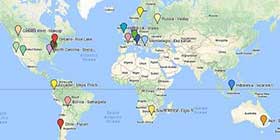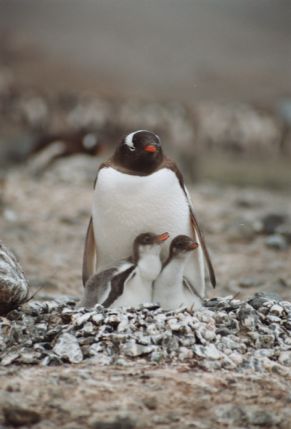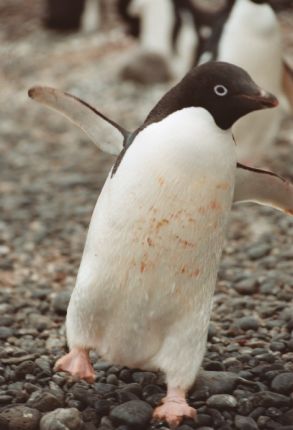Grant and Susan in Antarctica
Antarctica aboard the Disko - 30 Dec/97 - 7 Jan/98
"A journey is a person in itself, no two are alike...We find after years of struggle that we do not take a trip; a trip takes us." John Steinbeck
Icebergs floated serenely in the bay and snow capped peaks provided scenic photos. Seals lounged on the beach, and the numerous chinstrap penguins (named for the black lines across their chin) afforded comical wildlife encounters. Ahh, Antarctica!
Juvenile penguins 'chilling out' while their parents work
The Voyage
We boarded the Disko at 4:30 p.m. on 30 December, and found that she was a far cry from the spartan Russian research vessel we were expecting based on the information from the travel agent in Ushuaia. First, she wasn't Russian, but Danish, with a multinational crew. Second, she had never been a research vessel. She had been built as a Danish passenger vessel, originally used in Greenland, then completely refurbished this year and put into service in the Antarctic. She is ice hardened, just shy of being an icebreaker, but certainly okay for summer service down here. In the Antarctic winter she will be used in the Arctic.
Disko at Harbor - Antarctica
The ship is run by Marine Expeditions of Toronto. The captain is Danish, but many of the senior crew were Canadian, including Bill, the expedition leader; Dave and Laurie, two of the expedition guides (the other guides, Jeff and Theresa, were almost Canadians, as they live in Alaska) and Mary, the hotel manager, who looked after the guests while on board the ship.
The cabins were small but no smaller than some hotel rooms we've stayed in, with twin bunks, a toilet and shower, but no TV or phone (not too much of a sacrifice). After dumping our gear, we set off to explore the ship. We found a library and immediately scavenged for English language pocket books, as we had been unable to find any in Argentina. The library also had a number of games for passing the time in the Drake Passage, for those who weren't too seasick to want company. Finally, for entertainment there were large TV monitors so those with video cameras could enjoy watching their videos of the landings. This was also used extensively by the Japanese for karaoke sessions, as they had brought their own machine on board!
A forward lounge served as combined bar and lecture room. While we were at sea, there was a fairly full program of lectures on subjects ranging from the early Antarctic explorers to the numerous varieties of ice, as well as penguins, sea birds and marine mammals. Unfortunately, the forward lounge was also one of the most rolly spots on the ship, and with the curtains drawn for lectures you couldn't see the horizon line. For me, this was a guaranteed recipe for instant seasickness, so I didn't attend all the lectures, although Grant did, along with most other passengers.
The expedition guides were naturalists and most had lived extensively in the polar regions - Alaska and the Canadian Northwest Territories. They were very knowledgeable and enthusiastic about the birds, marine mammals and icebergs which people associate with Antarctica, and could always tell you what bird or species of seal you were seeing on the shore landings.
Crossing the Drake Passage takes 2 1/2 days each way. Going down we encountered extremely calm waters, such that the crew referred to it as Drake Lake. None of us were complaining, and we were able to enjoy a New Year's Eve party without much turbulence. On New Year's Day, we crossed the Antarctic Convergence, which is a separate body of water, and at 2 degrees C., is several degrees colder than further north. That day the first icebergs were also sighted, and we really started to feel like we weren't just on a posh cruise ship sailing the Caribbean!
Antarctica - Land Ho!
"And truly neither fish, flesh nor fowl is the penguin: as an edible, pertaining neither to Carnival nor Lent: without exception, the most ambiguous ... creature yet discovered by man. Though dabbling in all three elements, and indeed possessing some rudiment claims to all, the penguin is at home in none. On land it stumps, afloat it sculls, in the air it flops... Nature keeps this ungainly child hidden away at the end of the earth." Herman Melville
Who says I'm ungainly?
On 2 January we had an early breakfast while anchored at our first landing spot, and were in the Zodiacs going ashore before 9 a.m. We landed on Browns Bluff on the Antarctic Peninsula (if you can find a proper map of Antarctica, it's the long spike of land on the northwest corner of the continent). At S 63º31', W 56º53' this was also the furthest south point of landing for us. The fog was quite thick, but as we approached shore we could see them - tens of thousands of Adelie and Gentoo penguins waiting for us to come and appreciate them!
This is the nesting season for the penguins on the Antarctic Peninsula (by March this area will be deserted, as the chicks will all be old enough to go to sea). Some of the nests are high up on the rocky cliffs, but many are very close to shore, which does save a long climb for the penguins. The adults come ashore in hordes, and immediately begin searching for their chicks, who they recognize by their cries. Meanwhile, the chicks waylay any adult who passes by, hoping that this will turn out to be their parent and feed them.
When the adults do find their chicks, the chicks force their heads into the parents mouths, who then regurgitate the food they have caught for them. The chicks aren't tidy eaters, acting as if it was their only meal this week; it may have been for some.
This means that penguins just coming ashore are very photogenic, with clean white fronts, while those who are heading back out to sea have disgusting red and yellow stains all down their fronts and are not nearly as photogenic! Still, we photographed them anyway.
Although we became more blasé about penguins in subsequent landings, everyone was captivated by them. I disagree with Herman Melville, it seemed to me that at sea they move like dolphins, smoothly and gracefully in the water. On land they are very endearing to watch, as they climb (and stumble) their way up the rocks to their nests. They were certainly curious about us, and if you sat down at their level they would come quite close.
Even penguins hesitate to brave the frigid Antarctic waters!
All too soon it was time to leave. Back on the boat, we dried out and warmed up over lunch while the boat moved to our second landing spot, Hope Bay. Before landing, we heard an incredible story about this location and the Nordenskold Expedition of 1903-1905. Their boat arrived, dropped off a group for the summer to do some research and exploration (we'll call them Group A). At the end of the summer, when the group came back to the landing site, the boat was gone, forced to leave by the ice.
The boat went to a different location on the peninsula and dropped off another crew (Group B) with supplies for two weeks and instructions to try and make contact with Group A. Group B was unable to find Group A as weather conditions were already too bad, and when they went back to the landing site the boat was gone, again forced to leave by the ice. Both groups had no choice but to spend the winter, but whereas Group A was reasonably well supplied, Group B had minimal supplies and just barely survived.
Next spring, Group A happened to be heading north on an exploratory mission and met Group B coming south (absolutely amazing luck). The second group looked so bad that Group A thought they had discovered Antarctic aborigines! Meanwhile, the boat had come back to where Group B had been dropped, but they were no longer there. However, the landing party (Group C) could see tracks in the snow and so set off to try and find them. Group C finally catches up to the others at a spot appropriately named Point Well Met. They all survived and went back to the ship together. Amazing story of heroism, adventure and pure luck! We also appreciated this story since Hope Bay was not our planned landing site, but our boat couldn't reach the one that was planned because the ice was too thick, even though it is summer!
Today Hope Bay is the site of Esperanza Base, a permanent Argentine research station. Although some research is certainly done there, we suspect its main purpose is to reinforce Argentina's sovereignty claims to this area. In the 1970s the Argentineans flew a pregnant woman down to Antarctica so her child could be born in Antarctica, and there are families with young children living year round on the Esperanza Base. Argentina and Chile have overlapping claims in Antarctica, and though the Antarctic treaty froze all land claims, we observed while in Ushuaia that the province of Tierra del Fuego also has 'jurisdiction' over "Antartida Argentina".

Grant at Argentina's Esperanza Base - Antarctica
Frankly, the base stands out like a sore thumb, as the buildings are all painted bright orange. Blending in with the surroundings was obviously not a priority. Not as much to see here, but for those so inclined, there was shopping for souvenirs at the base cafeteria. They sell postcards which can be mailed (and duly postmarked) from the base, but the Japanese tourists had been there first and bought them all, so some folks were very disappointed. We bought a patch, as they didn't have souvenir spoons.
Deception Island
The next day, 3 January dawned with truly miserable weather - steady rain and wind dampened our enthusiasm for the bumpy Zodiac trip to shore. Our destination was Deception Island, an actual volcano about 7 miles across. Part of the wall has collapsed and allowed the sea water to flood the caldera, so ships can actually sail inside through a small opening to reach the inner harbour. It makes for a spectacular entrance. The first landing site, Whalers Bay, was a major Norwegian whaling station until the early 1930s, and later served as a British military base during WW2. Later still it became a scientific base, but the island is actually a volcano, and numerous eruptions in the 1960s culminated in a massive lava flow in 1969 which engulfed the base and resulted in its abandonment. The ruins of the buildings are all still there, partially filled with black volcanic rock. Although the fuel, batteries, etc. have been cleaned up, no decision has been made as to whether to remove the buildings and restore the site to its natural state, or leave the buildings for their historic value. The steady downpour made photography difficult, but certainly the weather suited the moodiness of the place.

Grant in Zodiac approaching land - Antarctica
The second landing was strictly frivolous - Pendulum Cove has natural hot springs (volcanic) which result in pockets of warm water and warm sand on the beach. So, we were there to go swimming! However, it was still raining, the air temperature was very cold, and the wind chill factor was significant, so not everyone thought this sounded like fun! The crew was surprised at the large turnout, though, considering the weather. An American couple, Art and Sharon, were the first ones to strip off and jump into the water. Although they didn't look like they were having too much fun, they certainly showed the Japanese that Americans are tough! Grant and I had, unfortunately, left our bathing suits (and shorts) in Ushuaia, as we hadn't expected there to be swimming in Antarctica, so we contented ourselves with staying warm and photographing the spectacle.
Half Moon Island
"To dine with a glacier on a sunny day is a glorious thing and makes feasts of meat and wine ridiculous. The glacier eats hills and drinks sun beams." John Muir
By the time of our last landing for the day, at Half Moon Island, the weather had cleared and the sun came out to give us a perfect Antarctic summer day. Icebergs floated serenely in the bay and snow capped peaks provided scenic photos. Weddel, fur and elephant seals lounged on the beach, and the numerous chinstrap penguins afforded comical wildlife encounters. Airi Hakone, a Japanese woman whose company is named Arica Penguin Co., and who told her husband he would always be second (to penguins) in her affections, was in penguin heaven, lying quietly on her stomach on the beach communing with the chinstraps.

Penguins on iceberg - Antarctica
We were all a very happy bunch of campers at the end of the day, and even if we'd been told we had to turn around and head back immediately to Argentina we would have been content with the experience. But we still had one more day!
Penguin Island / Turret Point
On 4 January, our morning destinations were Penguin Island, followed by a short Zodiac ride to Turret Point. By then, somewhat blasé about penguins, we took time to appreciate the numerous other seabirds nesting on these islands. We also encountered a number of elephant seals lolling on the beach, although it must be said that seals were seldom active enough to make an interesting photo.
I did get one unusual picture of a penguin jumping on a seal's stomach (mistook it for a rock?), which resulted in a quite comical reaction by the startled seal and the equally startled penguin. A highlight on the return to the boat was a Zodiac ride among the floating icebergs, which ranged from ice sculptures which looked like they had been carved, to massive walls of blue.
Penguin mistakes seal for rock - OOPS!!
Our final landing site at 7:00 p.m. that night was Aitcho Island. In dense fog (the Zodiac drivers had their GPSes out, and so did I), about a kilometer from the boat we found it. A craggy place, obviously popular with seabirds for the safe nesting spots.
We spent quite a bit of time photographing giant petrels on their nests, and the elephant seals belching and snorting on the beach, then back to the boat for a late dinner. While we ate the boat hauled up the anchor and headed back towards Argentina.
Return to Argentina
The trip back was somewhat more turbulent than going down, and the next night I, in common with many others, had a lot of trouble sleeping despite the Dramamine. The bunk arrangement meant that you rocked top to bottom rather than side to side, and for us short people that night also involved sliding from one end of the bunk to the other, necessitating holding on to the rails. The next morning we were pretty groggy, and breakfast was a rapid affair followed by a return to bed for more (attempted) sleep. Still, per the crew this was a very smooth crossing in both directions, even compared to the previous sailing, so we considered ourselves very fortunate.
Coming back we had still more lectures as well as an interactive discussion on the future of tourism in Antarctica. It's a controversial subject, especially as there are now full on cruise ships operating down here, albeit they are voluntarily restricting themselves to 400 passengers at a time. There is an association of Antarctic tour operators, and they abide by a code of conduct, but it's strictly voluntary, and there's no requirement for any operator to join the group. It may be only a matter of time before someone puts up a hotel and flies tourists in. That could really boost the numbers, as the Drake Passage crossing is a major deterrent currently.
The Disko's passengers were a surprise. None were the rich elderly types we had expected to find on board, but this was not a typical group. The entire ship had been originally booked by a Japanese tour company, but possibly due to the fall in the Japanese stock market they had been unable to sell all the cabins, so they freed up about 30 cabins just a few weeks before the sailing date. Marine Expeditions sold a few of these in the US, but most were sold in Ushuaia (at deep discounts), to the varied lot of folks down there over Christmas. Joe and Rona (not a couple) had been traveling through South America on an overland truck (Rona was taking her second trip to Antarctica in as many weeks, she had just come back on the previous voyage and gone right out again!), and many were backpacking and taking public transport. Geoff and Sandra, a British couple, were taking the boat in lieu of sailing down to Antarctica by themselves, which they had planned to do but encountered logistical problems in Ushuaia. Collectively, we represented about 18 countries among the 30 non-Japanese, which we were told was quite different from the usual passenger roster.
The staff assigned the Japanese to one side of the dining room, the rest of us to the other side, so we got to know everyone during the course of the week. The meals the kitchen staff prepared were consistently excellent, and we gorged ourselves like pigs all week. At dinner there was always a choice of fish, meat or vegetarian entrees, and on a couple of nights we had dessert buffets which were spectacular. We really looked forward to meal times, though perhaps not as much as those who had been backpacking! And there were even afternoon snacks, from apple turnovers to brownies.

Grant after too much good food on the Disko?
The sun returned again to permit sunbathing on the return journey (albeit fully clothed), and the trip back passed enjoyably. We rounded Cape Horn on the last night to incredibly calm weather again, and landed back in Ushuaia on the morning of the 7th January, feeling like we'd had a wonderful start to 1998! Our seventh continent, and like Africa, one to which we shall definitely return one day.
"I now belong to a higher cult of mortals, for I have seen the Albatross." Robert Cushman Murphy
Many thanks to Bill Davis of Marine Expeditions for the quotes.
Member login
Announcements
Thinking about traveling? Not sure about the whole thing? Watch the HU Achievable Dream Video Trailers and then get ALL the information you need to get inspired and learn how to travel anywhere in the world!
Have YOU ever wondered who has ridden around the world? We did too - and now here's the list of Circumnavigators!
Check it out now, and add your information if we didn't find you.
Are you an Overland Adventure Traveller?
Does the smell of spices wafting through the air make you think of Zanzibar, a cacophony of honking horns is Cairo, or a swirl of brilliantly patterned clothing Guatemala? Then this is the site for you!
Hosted by Grant and Susan Johnson, RTW 1987-1998
Johnson's Home
Who Are We?
The BIKE Story
Press Stories about us
Our "Rules of the Road"
Photo Album 500+ images
"Quick" highlights -
Top 31 photos
Mexico
Central America
New Zealand
Australia
Europe
England
Isle
of Man
Norway
Sweden
Denmark
Germany
Netherlands
Spain
Gibraltar
Africa
Tunisia
Libya
Egypt
Kenya
Tanzania
Malawi
Zimbabwe
Botswana
Namibia
Caprivi Strip
Etosha
Sossusvlei
South
Africa
South America
Argentina
Tierra del Fuego
Chile
Peru
Ecuador
Colombia
Next HU Events
HU Event and other updates on the HUBB Forum "Traveller's Advisories" thread.
ALL Dates subject to change.
2024:
- California: April 18-21
- Virginia: April 25-28
- Germany Summer: May 9-12
- Québec: May 17-19
- Bulgaria Mini: July 5-7
- CanWest: July 11-14
- Switzerland: August 15-18
- Romania: August 30-Sept 1
- Ecuador: August 24-25
- Austria: September 12-15
- France: September 20-22
- Queensland is back! Oct 4-7
- Germany Autumn: Oct 31-Nov.3
- South Africa: November
Add yourself to the Updates List for each event!
Questions about an event? Ask here
HU Achievable Dream is Online
and available now to stream on Vimeo!
ALL 15 chapters of the HU Achievable Dream Guide are available to download on Vimeo!
Binge watch over 18 hours of inspiring, informative and entertaining stories and tips from 150 travellers!
"a cross between entertaining stories, tech tips, and reference guide"
"A timeless introduction to Motorcycle Adventure Travel!"
Originally launched as a 7 DVD set, The Achievable Dream series can now be downloaded anywhere. OVER 18 hours of solid info take up zero space in your panniers. How convenient!
Books

All the best travel books and videos listed and often reviewed on HU's famous Books page. Check it out and get great travel books from all over the world.
NOTE: As an Amazon Affiliate we earn from qualifying purchases - thanks for your help supporting HU when you start from an HU Amazon link!




























